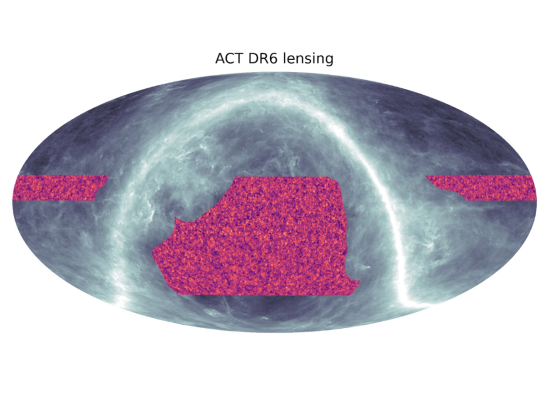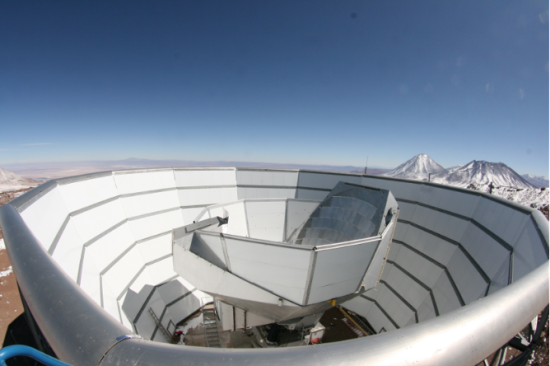May 2, 2023
Kavli Institute for the Physics and Mathematics of the Universe (Kavli IPMU)

Researchers from the Atacama Cosmology Telescope (ACT) collaboration, including the Kavli Institute for the Physics and Mathematics of the Universe (Kavli IPMU), have submitted a set of papers to The Astrophysical Journal, featuring a new map of dark matter distributed across a quarter of the entire sky, which confirms Einstein’s theory of how massive structures grow and bend light over the 14-billion-year life span of the universe.
For millennia, humans have been fascinated by the mysteries of the cosmos.
Unlike ancient philosophers imagining the universe’s origins, modern cosmologists use quantitative tools to gain insights into the universe’s evolution and structure. Modern cosmology’s origins were established in the early 20th century with the development of Albert Einstein’s theory of general relativity.
“We have mapped the invisible dark matter across the sky to the largest distances, and clearly see features of this invisible world that are hundreds of millions of light-years across,” said co-author and University of Cambridge Professor of Cosmology Blake Sherwin. “It looks just as our theories predict.”
Despite making up 85 per cent of the matter in the universe and influencing its evolution, dark matter has been hard to detect because it does not interact with light or other forms of electromagnetic radiation. As far as we know dark matter only interacts with gravity.
To track it down, more than 160 collaborators who built and gathered data from the National Science Foundation’s Atacama Cosmology Telescope in the high Chilean Andes observed light emanating following the dawn of the universe’s formation, the Big Bang—when the universe was only 380,000 years old. Cosmologists often refer to this diffuse light that fills our entire universe as the “baby picture of the universe,” but formally, it is known as the cosmic microwave background radiation (CMB).

The team tracked how the gravitational pull of large, heavy structures including dark matter warps the CMB on its 14-billion-year journey to us, like how a magnifying glass bends light as it passes through its lens.
“We’ve made a new mass map using distortions of light left over from the Big Bang,” said lead author of one of the papers and University of Pennsylvania Department of Physics and Astronomy Assistant Professor Mathew Madhavacheril. “Remarkably, it provides measurements that show that both the ‘lumpiness’ of the universe, and the rate at which it is growing after 14 billion years of evolution, are just what you’d expect from our standard model of cosmology based on Einstein's theory of gravity.”
Sherwin adds, “our results also provide new insights into an ongoing debate some have called ‘The Crisis in Cosmology,’” explaining that this stems from recent measurements that use a different background light, one emitted from stars in galaxies rather than the CMB. These have produced results that suggest the dark matter was not lumpy enough under the standard model of cosmology and led to concerns that the model may be broken. However, the team’s latest results from ACT were able to precisely assess that the vast lumps seen in this image are the exact right size.
“When I first saw them, our measurements were in such good agreement with the underlying theory that it took me a moment to process the results,” said University of Cambridge PhD student Frank Qu, lead author of one of the new papers. “It will be interesting to see how this possible discrepancy between different measurements will be resolved.”
To realize high-precision measurements of the lensing signals, however, the ACT team needed to mitigate contaminants from extragalactic foregrounds.
Kavli IPMU Project Assistant Professor Toshiya Namikawa is a co-author on these papers and has made major contributions to the analysis, in particular to accurately measuring a lensing map without foreground. For example, a method called bias-hardening, which he originally developed, was used to successfully mitigate these potential biases. This method will be a fundamental tool for accurately estimating lensing maps from future CMB experiments, including the Simons Observatory, in which several researchers from the Kavli IPMU are involved.
“The CMB lensing data rivals more conventional surveys of the visible light from galaxies in their ability to trace the sum of what is out there,” said ACT Director Suzanne Staggs.
“When we proposed this experiment in 2003, we had no idea the full extent of information that could be extracted from our telescope,” said University of Pennsylvania Reese Flower Professor of Astronomy and ACT Deputy Director Mark Devlin. “We owe this to the cleverness of the theorists, the many people who built new instruments to make our telescope more sensitive, and the new analysis techniques our team came up with.”
ACT, which operated for 15 years, was decommissioned in September 2022. Nevertheless, more papers presenting results from the final set of observations are expected to be submitted soon, and the Simons Observatory will conduct future observations at the same site, with a new telescope slated to begin operations in 2024. This new instrument will be capable of mapping the sky almost 10 times faster than ACT.
Read the full article by the ACT Collaboration here.
Paper details (involving Kavli IPMU researchers)
Journal: Submitted to The Astrophysical Journal (11 April 2023)
Paper title: The Atacama Cosmology Telescope: Mitigating the impact of extragalactic foregrounds for the DR6 CMB lensing analysis
Authors: Niall MacCrann (1), Blake D. Sherwin (1, 2), Frank J. Qu (1), Toshiya Namikawa (3), Mathew S. Madhavacheril (4), Irene Abril-Cabezas (1), Rui An (5), Jason E. Austermann (6), Nicholas Battaglia (7), Elia S. Battistelli (8), James A. Beall (6), Boris Bolliet (1), J. Richard Bond (9), Hongbo Cai (10), Erminia Calabrese (11), William R. Coulton (12), Omar Darwish (13), Shannon M. Duff (6), Adriaan J. Duivenvoorden (12, 14), Jo Dunkley (14, 15), Gerrit S. Farren (1), Simone Ferraro (16), Joseph E. Golec (17, 18), Yilun Guan (19), Dongwon Han (1), Carlos Hervías-Caimapo (20), J. Colin Hill (21), Matt Hilton (22), Renée Hložek (23, 24, 25), Johannes Hubmayr (6), Joshua Kim (4), Zack Li (9), Arthur Kosowsky (26), Thibaut Louis (27), Jeff McMahon (18, 28, 17, 29), Gabriela A. Marques (30), Kavilan Moodley (31), Sigurd Naess (32), Michael D. Niemack (33, 7), Lyman Page (14), Bruce Partridge (34), Emmanuel Schaan (35, 36), Neelima Sehgal (37), Cristóbal Sifón (38), Edward J. Wollack (39), Maria Salatino (40), Joel N. Ullom (6), Jeff Van Lanen (6), Alexander Van Engelen (41), Lukas Wenz (7)
Author affiliations:
1 DAMTP, Centre for Mathematical Sciences, University of Cambridge, Wilberforce Road, Cambridge CB3 OWA, UK
2 Kavli Institute for Cosmology Cambridge, Madingley Road, Cambridge CB3 0HA, UK
3 Kavli IPMU (WPI), UTIAS, The University of Tokyo, Kashiwa, 277-8583, Japan
4 Department of Physics and Astronomy, University of Pennsylvania, 209 South 33rd Street, Philadelphia, PA, USA 19104
5 Department of Physics and Astronomy, University of Southern California, Los Angeles, CA 90089, USA
6 NIST, Quantum Sensors Group, 325 Broadway, Boulder, CO, 80305
7 Department of Astronomy, Cornell University, Ithaca, NY 14853, USA
8 Sapienza—University of Rome—Physics department, Piazzale Aldo Moro 5—I-00185, Rome, Italy
9 Canadian Institute for Theoretical Astrophysics, University of Toronto, Toronto, ON, Canada M5S 3H8
10 Department of Physics and Astronomy, University of Pittsburgh, Pittsburgh, PA, USA 15260
11 School of Physics and Astronomy, Cardiff University, The Parade, Cardiff, Wales CF24 3AA, UK
12 Center for Computational Astrophysics, Flatiron Institute, 162 5th Avenue, New York, NY 10010, USA
13 Université de Genève, Département de Physique Théorique and Centre for Astroparticle Physics, 24 quai Ernest-Ansermet, CH-1211 Genève 4, Switzerland
14 Joseph Henry Laboratories of Physics, Jadwin Hall, Princeton University, Princeton, NJ, USA 08544
15 Department of Astrophysical Sciences, Peyton Hall, Princeton University, Princeton, NJ 08544, USA
16 Lawrence Berkeley National Laboratory, One Cyclotron Road, Berkeley, CA 94720, USA
17 Department of Physics, University of Chicago, 5720 South Ellis Avenue, Chicago, IL 60637, USA
18 Kavli Institute for Cosmological Physics, University of Chicago, 5640 South Ellis Avenue, Chicago, IL 60637, USA
19 Dunlap Institute for Astronomy and Astrophysics, University of Toronto, 50 St. George St., Toronto, ON M5S 3H4, Canada
20 Instituto de Astrofísica and Centro de Astro-Ingeniería, Facultad de Física, Pontificia Universidad
Católica de Chile, Av. Vicuña Mackenna 4860, 7820436 Macul, Santiago, Chile
21 Department of Physics, Columbia University, 538 West 120th Street, New York, NY, USA 10027
22 Wits Centre for Astrophysics, School of Physics, University of the Witwatersrand, Private Bag 3, Johannesburg 2050, South Africa
23 David A. Dunlap Department of Astronomy & Astrophysics, 50 St George Street, Toronto ON M5S 3H4
24 Dunlap Institute for Astronomy & Astrophysics, 50 St George Street, Toronto ON M5S 3H4
25 Astrophysics Research Centre, University of KwaZulu-Natal, Westville Campus, Durban 4041, South Africa
26 Department of Physics and Astronomy, University of Pittsburgh, Pittsburgh, PA 15260 USA
27 Université Paris-Saclay, CNRS/IN2P3, IJCLab, 91405 Orsay, France
28 Department of Astronomy and Astrophysics, University of Chicago, 5640 S. Ellis Ave., Chicago, IL 60637, USA
29 Enrico Fermi Institute, University of Chicago, Chicago, IL 60637, USA
30 Fermi National Accelerator Laboratory, P. O. Box 500, Batavia, IL 60510, USA
31 Astrophysics Research Centre, School of Mathematics, Statistics and Computer Science, University of KwaZulu-Natal, Durban 4001, South Africa
32 Institute of theoretical astrophysics, University of Oslo, Norway
33 Department of Physics, Cornell University, Ithaca, NY 14853, USA
34 Department of Physics and Astronomy, Haverford College, Haverford PA, USA 19041
35 SLAC National Accelerator Laboratory, Menlo Park, CA 94025, USA
36 Kavli Institute for Particle Astrophysics and Cosmology and Department of Physics, Stanford University, Stanford, CA 94305, USA
37 Physics and Astronomy Department, Stony Brook University, Stony Brook, New York 11794, USA
38 Instituto de Física, Pontificia Universidad Católica de Valparaíso, Casilla 4059, Valparaíso, Chile
39 NASA Goddard Space Flight Center, 8800 Greenbelt Rd, Greenbelt, MD 20771 USA
40 Physics Department, Stanford University, 382 via Pueblo, Stanford 94305 CA USA
41 School of Earth and Space Exploration, Arizona State University, Tempe, AZ, USA 85287
Pre-print (arXiv.org)
Research contact
Toshiya Namikawa
Project Assistant Professor
Kavli Institute for the Physics and Mathematics of the Universe
University of Tokyo
E-mail: toshiya.namikawa_at_ipmu.jp
* Change _at_ to @
Media contact
Motoko Kakubayashi
Press officer
Kavli Institute for the Physics and Mathematics of the Universe
University of Tokyo
TEL:04-7136-5980
E-mail:press_at_ipmu.jp
* Change _at_ to @
Related links
The Atacama Cosmology Telescope: A Measurement of the DR6 CMB Lensing Power Spectrum and its Implications for Structure Growth (ACT Collaboration pre-print paper submitted to The Astrophysical Journal, 11 April 2023)
The Atacama Cosmology Telescope: DR6 Gravitational Lensing Map and Cosmological Parameters (ACT Collaboration pre-print paper submitted to The Astrophysical Journal, 11 April 2023)
1-minute video of ACT (Credit: Debra Kellner)
Atacama Cosmology Telescope website
Notes
This work was supported by the U.S. National Science Foundation (AST-0408698, AST-0965625 and AST-1440226 for the ACT project, as well as awards PHY-0355328, PHY-0855887 and PHY-1214379), Princeton University, the University of Pennsylvania, and a Canada Foundation for Innovation award. Authors at the University of Cambridge were supported by the European Research Council.






